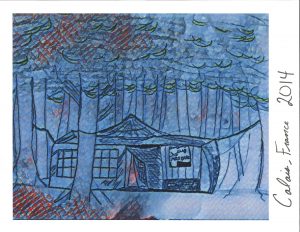Calais, France

What makes this tent a mosque? Is it the tarp maneuvered to form a type a dome like space at the top of the tent? Is it the sign on the front that says “Mosque” in both English and Arabic? In 2014, migrants from Afghanistan, Sudan, Iran, and Eritrea made camp outside of Calais, France en route to the UK. Much attention from the European press was made concerning a tent they pitched to form a place of worship. Inside, the mosque is outfitted with rugs and books. I was drawn to this photo because it depicts the way that cultural signifiers of Islamic architecture that are not detailed in the Quran have been transported outside of the boundaries of nation or state. In the photo, an attempt to replicate a dome that aesthetically represents a space for heaven has been made. I create this drawing with colored pencils and then edited it online to add red definition and highlight. This rendering also explores the definition of a place a worship that is not clearly outlined in the Quran. In this example, a mosque is mobile and sans-minurete. The attempt by migrants to create a dome is barely realistic of some kind of spire, and yet, the cultural markers of middle eastern architecture do not determine if this is a mosque. What designates this space as a mosque is the cleanliness of the space, the direction of worshipers, and the intention of the space. All these are present. Our discussions in class about the differences of Islamic aesthetic interpretation are complicated in a world where borders do not designate cultural separation. This artistic rendering of a photo of the tent they pitched explores concepts of architecture and the aesthetic of the Mosque, which we explored in Week 6.
The inspiration for the drawing comes from the following Daily Mail article: http://www.dailymail…